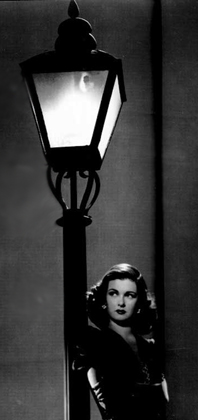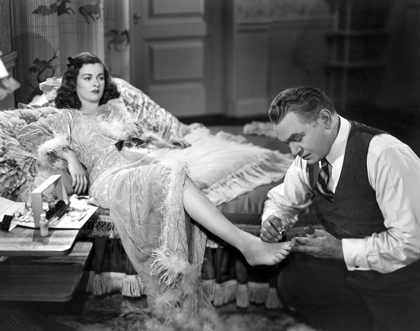
 |
|
|
|
One of the best films noir ever and Fritz Lang's personal favorite of his American work, Scarlet Street is a perfect expression of the director's theme of deterministic fate. It's also a fascinating downbeat drama about the price of being a feeling person in an uncaring world. Lang and screenwriter Dudley Nichols prepare a bizarre narrative trap for a fatal triangle of romantic deceivers. Yet the picture is much more than just a trick plot. As portrayed by Edward G. Robinson, Joan Bennett and Dan Duryea, character and fate are inseparable. Kino's fine Blu-ray presents Scarlet Street in an almost spotless print restored from a 35mm negative preserved by the Library of Congress. Before the 2005 restoration most of us could not see this classic in a quality presentation -- previous videos were Public Domain eyesores with garbled audio. Here, every nuance of Fritz Lang's typically adventurous soundtrack are perfectly rendered - the buzzing weirdness of Chris Cross's guilty nightmares, and the haunted, whispered voices that chill to the bone: "Come here, Lazylegs!" "Jeepers ... I love you Johnny!" 
True to form, the story begins on a rainy night in New York. Milquetoast cashier Chris Cross (Edward G. Robinson) is impressed to find that his boss has a mistress. He considers himself lucky to chance upon Katherine "Kitty" March (Joan Bennett), a trollop being beaten up by her boyfriend Johnny Prince (Dan Duryea). Chris is too naíve to realize that Kitty is a streetwalker. The underhanded Johnny uses Kitty as bait to get money from Chris, who they take to be a rich man and a famous artist. Chris is really a Sunday painter henpecked by his shrewish wife Adele (Rosalind Ivan). He's innocently enraptured by what he thinks to be a lonely actress. Kitty and Johnny's cruel plan works well until art critics try to track down the painter behind Chris' unsigned works --- the influential trend setters think that his paintings are great modern art. The trouble is, Johnny is already claiming that they're Kitty's own work. Fritz Lang and Joan Bennett were part of a creative partnership called Diana Productions that did good business with 1944's The Woman in the Window, itself a noir classic about a mild-mannered man drawn into an erotic nightmare. Enchanted by the reflection of a real woman who matches a painting in the window of an art dealership, Robinson spends time with her only to find himself ensnared in the murder of a loutish young man played by Dan Duryea. As skillful as it was, The Woman in the Window employed a dream framework as a serious narrative cheat, possibly to evade censorship. As if improving on an earlier draft, Lang returned to a similar formula for Scarlet Street. This time the nightmare is no dream from which the fatalistically named Chris Cross can awaken. Kitty March is first glimpsed in a transparent raincoat, looking like a piece of candy wrapped in cellophane. Chris is immediately hooked beyond rescue. Lang and Nichols scoop Vladimir Nabokov's Lolita when Kitty maneuvers Chris into painting her toenails -- an overt expression of sexual domination. Chris will cheat on his wife and embezzle from his job to maintain an illusion of love with the venomous Kitty. When Chris finally realizes he's been duped, he'll do a lot more. Caught in his crimes after throwing his life away "because of a woman", Chris is castigated by his boss, a married man who himself openly carries on with a mistress. Chris is a worst-case example of a man in a mid-life crisis, incapable of making sound decisions for himself. To Lang he's an everyman, ready to lose his soul over a lost dream of youthful love. 
Scarlet Street cleared the censors but was banned in three states anyway for its 'immoral' story. In the original book (filmed by Jean Renoir under its French title, which translates as The Bitch) the Kitty character is much more openly a prostitute. Dudley Nichols's script does some fancy footwork to explain that Kitty is just the pampered, masochistic girlfriend of Johnny Prince, and not being pimped by him. There's hardly a distinction, as Johnny clearly spends wild drunken nights with Kitty, and encourages her to "charm" Chris Cross as well as an art critic that might lead them to some easy cash. We're attracted to Kitty but are more dismayed by her effect on Chris, whom we like a lot more; he's so unaccustomed to lies that Kitty is able to manipulate his feelings with the cheapest of tricks, all the while laughing behind his back. In The Woman in the Window we saw Robinson's misadventures from the outside. Scarlet Street often lets us identify directly with Chris Cross: we experience both his outrage and his twisted sense of justice. Scarlet Street also has a lot to say about the relationship between art, love and happiness. Chris Cross's urge to express his feelings comes through in his crude but imaginative canvasses. Paintings made for use as movie props often look like cheap knockoffs from the art department, but these convince as amateur work that might be recognized as great modern art. They communicate pure emotion without an investment of ego. When he discovers that Kitty is signing them and taking credit, Chris couldn't he happier. He doesn't believe that he could ever sell a painting, and he takes are act as a cementing of their relationship. Chris's is the exact opposite of the venal and corrupt Johnny Prince. In Lang's dispassionate worldview, both men are apt to be burned by the hand of fate. Perhaps the Furies of the opening of the Hecht-MacArthur Crime Without Passion are drawn to destroy men as virtuous as Chris and as corrupt as Johnny --- both upset the balance of good and evil. (Some big spoilers in the next two paragraphs) More than one scholarly analysis has examined the actual murder scene at length, noting Kitty's reflections in the mirror, the illusion of her crying/laughing and especially the way Lang keeps Chris Cross's moment of violent decision off-screen. The victim, the motive and the weapon seem to assemble themselves into a pattern that encourages Chris to lose control. Kitty laughs cruelly when Chris thinks she is crying ("You idiot!") suddenly turns to terror. We immediately know why, as Kitty is practically begging to be murdered. Lang invents a basic convention of the slasher film: an impotent man 'penetrates' a female he perceives as castrating, by piercing her with a sharp weapon, repeatedly. 
Most Lang films about murder are acutely aware of the social implications of capital punishment. Fury, You Only Live Once, this movie and Beyond a Reasonable Doubt are all investigations of the nature of capital crime and what it means when a mob or a government takes a life. In a way Scarlet Street is the purest horror film of the group. An innocent man is convicted, sentenced and executed for a crime he didn't commit, a development that goes completely against the Production code. Scarlet Street invents a punishment for the real guilty party more horrible than execution. As a cynical reporter tells Chris Cross, a man who gets away with murder soon learns that he'd be better off being given the works by a judge, than be tortured by the pitiless judge and jury of his own conscience. The film's extended coda is one of the darkest in film noir. The guilty party has destroyed or lost everything dear to him, even his own identity. He lives in a haunted, claustrophobic personal hell, perpetually hearing the voices of his victims: "Come here, Lazylegs!" "Jeepers ... I love you Johnny!" The echoes ring in the mind. Woman in the Window was able to end on a whimsical note of reassurance that spelled box office success. By contrast Scarlet Street opts for an incomparably oppressive doom-laden finale. Viewers often come away saying it's the creepiest, darkest old film they've ever seen... but they never forget it. Kino Classics' Blu-ray of Scarlet Street grants this powerful noir thriller a terrific HD encoding. Joan Bennett's plastic raincoat finally displays the dime-store sheen that comes across in the film's many handsome still photos. Lang plays many scenes at a medium-wide distance, and the increased resolution allows us to read more expression into the actors' faces. Of course, Bennett's many close-ups are intoxicating. On her, lolling around on a sofa and spitting looks good. She's even more of an erotic hallucination than she was in Woman in the Window A couple of deleted scenes are depicted through stills in a photo and advertising art gallery, where we also learn that the film's Spanish title is Perversidad ("Perversity"). But the real attraction is David Kalat's fact- packed commentary. Kalat knows how to interpret all of Lang's visual road signs, such as Dan Duryea dissolving into the image of a painted snake. One of the few things Kalat doesn't mention is that Ms. Bennett was practically blind without extreme corrective lenses and could barely focus enough to see the other actors on the set. Fooled us - those big eyes seem to look right through a man.
On a scale of Excellent, Good, Fair, and Poor,
Scarlet Street Blu-ray rates:
Reviews on the Savant main site have additional credits information and are often updated and annotated with reader input and graphics. Also, don't forget the 2011 Savant Wish List. T'was Ever Thus.
Review Staff | About DVD Talk | Newsletter Subscribe | Join DVD Talk Forum |
| ||||||||||||||||||